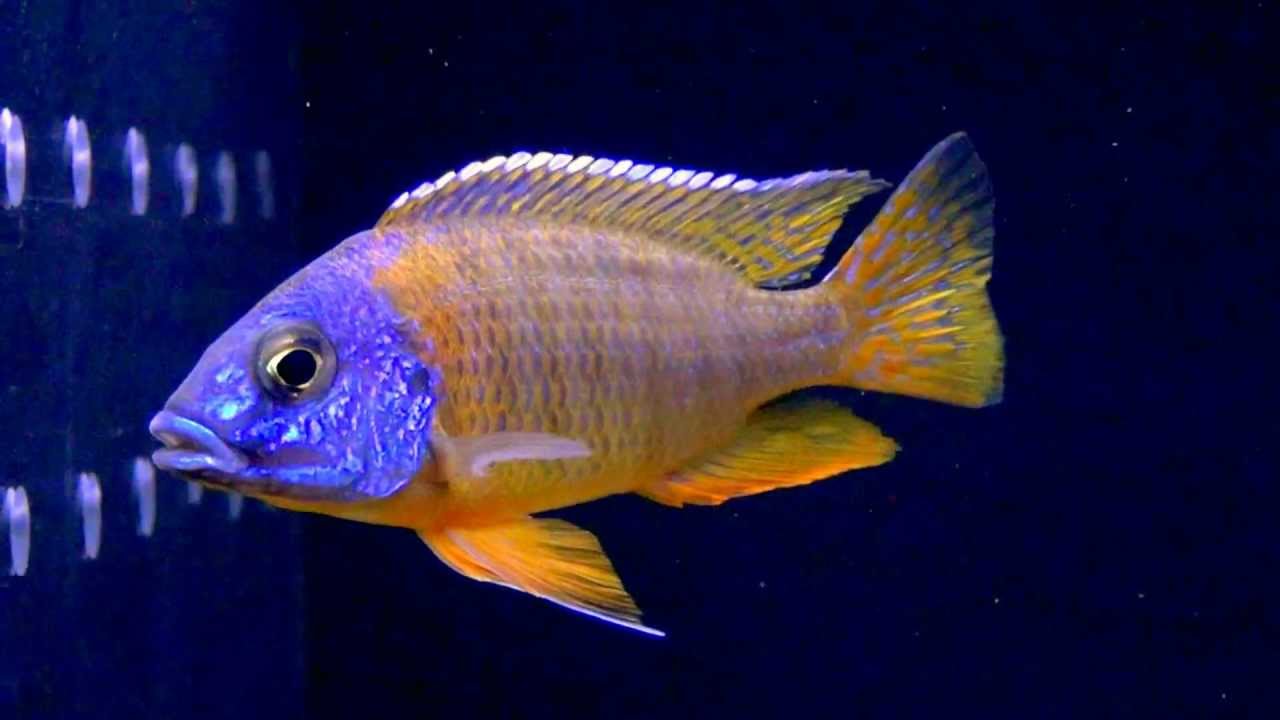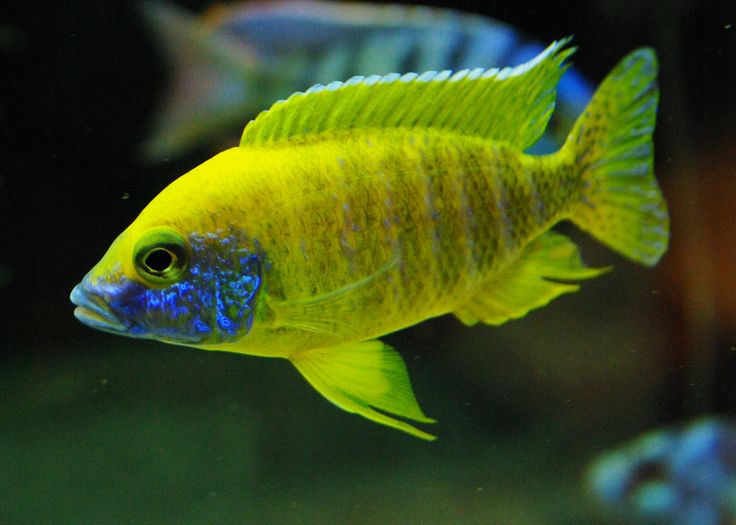Sunshine Peacock Cichlid
The Sunshine Peacock, stuartgranti maleri, should make a grand entry into your aquarium.
Known for its dazzling colors and mild demeanor, a contrast to its cichlid kin, the Sunshine Peacock stirs up the aquarium scene like no other.
- Experience Level: Beginner
- Hardiness: Hardy
- Minimum Tank Size: 75 gal (285 L)
- Maximum Size: 7 inches (18 cm)
- Temperament: Semi-Aggressive
- Temperature: 74 – 82° F (23.3 – 27.7° C)
- pH Range: 7.8 – 8.6
- Water Hardness: 6 – 10 dGH
- Diet: Omnivore
Table of Contents
Introduction
Size and Appearance
Care Guide
Tank Mates
Diet and Feeding
Breeding
The Sunshine Peacock calls the waters around Maleri Island, Lake Malawi home, a lake listed among Africa’s four largest and straddling Malawi, Mozambique, and Tanzania. With more than 10 million years under its belt, Lake Malawi is host to a diverse mixture of evolved and unique fish species.
The splendorous color variations of blue, yellow, and red, exhibited by all members of Aulonocara, have them aptly labeled as “peacock cichlids.”
Size and Appearance
The span of a Sunshine Peacock is generally five to seven inches, with males usually sizing up larger than their female counterparts.
Nothing rivals the sight of a Sunshine Peacock displaying its brilliant yellow body contrasted by a luminescent blue face. The glowing blue pops against the matte yellow body, enhancing the beauty of the white-edged dorsal fin bordering the body.
Drawing on color wheel fundamentals, you’ll recall that blue and yellow are opposites, offering a splash of contrast that will liven up your aquarium. That’s where the Sunshine Cichlid earns its stripes!
Unlike some species, the color of the Sunshine Peacock remains stable and doesn’t change according to mood or breeding status. However, female and juvenile cichlids aren’t as gloriously colored as adult males, so consider choosing a male if color vibrancy is your goal.
Their appearance can exhibit slight variances based on the location they hail from. Those from Maleri Island may predominantly feature a yellow face while other strains might be bluer. Specimens from Chipoka tend to sport a deep indigo head, while those bred in captivity tend to be between orange and yellow.
Sunshine Peacocks, found between six to 40 meters deep in Lake Malawi, are typically middle-tier swimmers in an aquarium setting.
Brightly colored and lively, Sunshine Peacocks jazz up your aquarium by exploring decorations, swimming around plants, and searching for hidden delicacies in the sand. Though they don’t need to forage for food in captivity, it’s an intrinsic activity.
While African cichlids do demonstrate varying aggressiveness levels due to territorial disputes, the Sunshine Peacock diverges from this trait and is less hostile. Instead of using aggression to establish dominance or create a pecking order, males of this species only show aggression while competing for mates or guarding offsprings.
Creating a peacefully dynamic and colorful aquarium with an all-male Sunshine Cichlid tank is an option if breeding isn’t on the cards. If breeding piques your interest, maintain a 1:3 male-to-female ratio to minimize aggression.
The Sunshine cichlid is readily available, making it likely to find it at nationwide pet supply chains like Petco or Petsmart. Local fish stores might stock them as well. But remember, just because the label reads “Sunshine Peacock,” it doesn’t guarantee authenticity.
Care Guide
- Minimum Tank Size: 75 gal (285 L)
- pH Range: 7.8 – 8.6
- Water Hardness: 6 – 10 dGH
- Temperature: 74 – 82° F (23.3 – 27.7° C)
- Lighting: Moderate, diffused lighting
- Substrate: Fine sand/gravel
- Brackish: No
- Water Flow: Low to moderate
- Tank Region: All areas
With the right balanced diet and suitable environment, Sunshine Peacocks can grace your aquarium for six to 10 years. Contrary to popular belief, adding salt to an African cichlid habitat isn’t advisable. Not only does this not increase water hardness or pH levels, but it also paves the way for Malawi bloat.
Infusing water with dissolved calcium and magnesium yields alkaline or “hard” water. Commercial buffers like SeaChem’s Cichlid Salt are safer and more effective in increasing water hardness. To accommodate a trio of Sunshine Peacocks (ideally a male and two females), a short, wide tank capable of holding 75 gallons of water is necessary. Should you plan on adding more cichlid-friendly inhabitants later, you’ll need to upgrade to a tank that can hold a minimum of 125 gallons.
Managing larger tanks isn’t necessarily a daunting task than maintaining smaller ones. Larger tanks ensure more stable water chemistry, preventing sudden chemical swings like ammonia spikes.
As they generally prefer more horizontal swimming space, opt for a wider tank, allowing for increased water surface area and consequently better oxygen exchange.
The ideal substrate for these African cichlids would be a combination of fine sand sprinkled with some gravel. The addition of crushed corals and seashells releases carbonates into the water, boosting the pH.
Decorate the tank with live or artificial plants, providing visual interest and creating hideaways for the fish. While plastic plants are low-maintenance with no special lighting needs, you can benefit from these live cichlid-compatible plant options:
- Anacharis
- Anubia
- Cryptocoryne usteriana
- Green Cabomba
- Hornwort
- Java Fern
- Java Moss
Real aquatic plants help by absorbing carbon dioxide and nitrates while releasing oxygen into the water.
In addition to plants, arranging rocks in the tank will also make your Sunshine cichlids feel at home. Courting males prefer to stake their claim over a chosen piece of rock.
Tank Mates
Often living up to their name, Sunshine cichlids’ sunny nature makes them usually peaceful, thus smoothly integrating into a community tank. Pairing them with medium-sized species that share a similar temperament and water conditions would be a smart move. Here are some tank mate possibilities:
- Botia kubotai (Polka Dot Loach)
- Sciaenochromis fryeri (Electric Blue Hap)
- Copadichromis borleyi (Redfin Hap)
- Macropodus opercularis (Paradise Gourami)
- Melanotaeniidae (Rainbowfish)
- Phenacogrammus interruptus (Congo Tetra)
However, avoid housing Sunshine cichlids with other Aulonocara species to prevent the risk of hybridization.
Feeding Guide
- Diet: Omnivore
- Frequency: Several small feedings per day
- Pellet Foods: Yes
- Flake Foods: Yes
- Live Foods: Yes
- Meat Foods: Yes
- Vegetable Foods: Yes
Omnivorous Sunshine cichlids thrive on insects, meat, algae, and plant detritus in the wild, lying in wait near the bottom for crustaceans. Providing a high-protein diet comprising flakes, pellets, and granules while in captivity meets their nutritional needs.
Carnivore pellets, sinking to the bottom, work best as your cichlids would be foraging around this area for food. Feed your pets in small portions throughout the day rather than a single large meal.
Despite suggestions for using Tubifex worms, bloodworms, or beef heart in some sources, it’s critical to remember that while larger Malawi cichlids may tolerate such foods, smaller cichlid species like peacock cichlids might experience digestive issues.
Balanced nutrition for omnivores like your fish includes occasionally supplementing their high-protein diet with blanched veggies or cut fruits. A strictly carnivorous diet could lead to digestive ailments and potential parasite infestations. As special treats, you can offer brine shrimp or chopped tilapia to your peacock cichlids.
Breeding
Similar to other Aulonocara species, Sunshine Peacocks are mouthbrooders that organize matriarchal societies. If breeding is something you’re considering, maintaining a ratio of one male to two females will promote breeding success.
The male Sunshine Peacock’s color intensifies during the breeding process. To draw females, males will show off their enhanced colors and perform a dance. If a female takes interest, she responds by following the male, leading to a partnered dance.
After, the female lays her eggs and gathers them in her mouth. She’ll then peck at the male’s anal fin, a signal for him to provide sperm. The female safeguards the fertilized eggs in her mouth until they hatch and during this period, she’ll conceal herself, rarely eating.
Parenting is a quality that peacock cichlids excel at, making them an endearing species. Females protect their offspring using a mouthbrooding strategy, while males oversee the young until they’re capable of self-defense, unlike other species that neglect this role, occasionally resorting to eating their own young!
If you’re keen on successful breeding, establishing a dedicated breeding tank exclusively for your peacock cichlids is prudent. Apart from protecting your couple’s offspring from potential predators, segregating Sunshine cichlids from similar-looking species is crucial for bloodline purity.
However, inbreeding over time can lead to color mutations, causing the Sunshine Peacock cichlid to exhibit deeper blues and orange hues instead of yellow.



